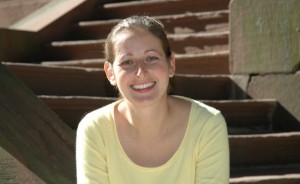NSF Grant Lets Shusterman Study Connections Between Children’s Acquisition of Language, Number Concepts

Anna Shusterman, assistant professor of psychology, recently received a five-year, $716,227 grant from the National Science Foundation (NSF) to study “The role of language in children’s acquisition of number concepts.” Shusterman will be evaluating 3-to-5-year-old hearing children in her Cognitive Development Laboratory at Wesleyan. She also will be studying deaf and hard-of-hearing children of the same ages who are learning English to try to determine how language delays affect children’s learning of number concepts.
The grant, which begins this year, comes from the National Science Foundation’s Faculty Early Career Development (CAREER) program. The program is only available to non-tenured faculty. Researchers may apply a total of three times to the program; Shusterman was awarded the grant on her first application.
“The CAREER Program truly provides NSF’s most prestigious awards in support of junior faculty and demonstrates the Foundation’s confidence in Dr Shusterman’s ability to represent this country’s next generation of leadership in research and education,” says Lisa Dierker, chair and professor of psychology.
The grant falls under the NSF’s Research and Evaluation on Education in Science and Engineering (REESE) program.
“This program is about the foundations of science, technology, engineering, and mathematics (STEM) learning,” Shusterman says. “If children cannot count or do not know what individuals numbers mean, they cannot progress in their STEM education.”
Shusterman studied deaf populations during her time in Nicaragua when she examined people using and learning the newly-developed Nicaraguan Sign Language. For this NSF grant she chose to study children who were oral-deaf rather than those who used a formalized sign language such as American Sign Language because the preschool age oral-deaf children receive language input only once their hearing is corrected though a hearing aid or a cochlear implant. Children learning ASL can receive language input as soon as somebody starts signing around them. Many deaf children have only an “auditory perception problem and are cognitively right on par” with others, she says.
“It’s important for not only cognitive researchers to learn about children’s acquisition of number concepts, but for preschool, kindergarten and elementary school math educators to have more insight into how children learn exactly what numbers are,” Shusterman says.
“If we know that conceptual numerical skills are delayed in the oral-deaf population because they are language-delayed, then this delay could entrench otherwise bright children on a path away from optimal mathematical learning in school and other contexts. This knowledge can directly translate into interventions that reduce the well-documented achievement gap between deaf and hearing students in STEM disciplines,” according to the grant application.
Shusterman will be studying symbolic (e.g. estimations of greater and lesser quantities of dots) and nonsymbolic (Arabic numerals) representations of numbers. Children often recite numbers without knowing their meaning. They might be able to recite numbers up to five, but only know that the word “one” means means one ball. These children might see a picture of two dogs and recognize that there are two of them but others might see a picture of four or five dogs and still announce that there are two dogs because they haven’t yet learned how two is different from three, four or five. Yet they have learned how the number one is different from other numbers.
The studies that Shusterman, her full-time research assistant and undergraduates will be undertaking will likely be similar to previous studies conducted at the Cognitive Development Lab. For example, in one recent study to test children’s understanding of quantities, Shusterman’s team presented children with caterpillars that each had different amount of feet. The children were not told to count the feet nor told how many feet each caterpillar has. Instead, they were asked to pick out the exact number of socks for the caterpillar. Kids from ages 3 to 5 usually did not have difficulty selecting the correct number of socks when the quantity of feet are low, but they struggled when there were a higher number of feet (i.e. over three).
The five-year NSF-funded project will include annual workshops on number development for both early childhood educators and educators of the deaf, a summer fellowship program for undergraduate students, and the development of a course in which undergraduates design a mathematics curriculum for a deaf preschool. The studies will also lead to methods to evaluate and distribute preschool mathematics programs for deaf and hard-of-hearing children.
“Our students and the community will benefit enormously from these new undergraduate training opportunities, research-based workshops for early childhood educators, and the creation of research-based educational materials in partnership with local schools, ” Dierker says.
“Praise also goes to Wesleyan which provides invaluable support for this work in the form of outstanding research facilities, a firm commitment to liberal education and to the teacher-scholar model, along with ongoing support for faculty development,” she says. “The interaction between this capacity and the excellence and dedication of our faculty plays a significant role in the ability to successfully compete for these prestigious awards.”

